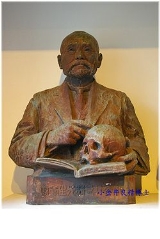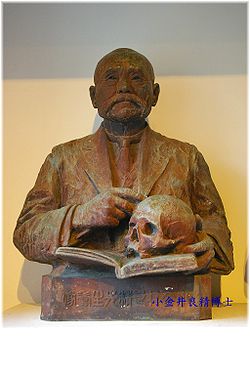
Koganei Yoshikiyo
Encyclopedia

Meiji period
The , also known as the Meiji era, is a Japanese era which extended from September 1868 through July 1912. This period represents the first half of the Empire of Japan.- Meiji Restoration and the emperor :...
.
A child of an Echigo Nagaoka clansman, he graduated from East School, the precursor of the Tokyo Imperial University
University of Tokyo
, abbreviated as , is a major research university located in Tokyo, Japan. The University has 10 faculties with a total of around 30,000 students, 2,100 of whom are foreign. Its five campuses are in Hongō, Komaba, Kashiwa, Shirokane and Nakano. It is considered to be the most prestigious university...
medical school, in 1880. He then went to Germany
Germany
Germany , officially the Federal Republic of Germany , is a federal parliamentary republic in Europe. The country consists of 16 states while the capital and largest city is Berlin. Germany covers an area of 357,021 km2 and has a largely temperate seasonal climate...
where he learned anatomy
Anatomy
Anatomy is a branch of biology and medicine that is the consideration of the structure of living things. It is a general term that includes human anatomy, animal anatomy , and plant anatomy...
and histology
Histology
Histology is the study of the microscopic anatomy of cells and tissues of plants and animals. It is performed by examining cells and tissues commonly by sectioning and staining; followed by examination under a light microscope or electron microscope...
. He returned to Japan in 1885, and in the following year he was appointed a professor at Tokyo Imperial University Medical School, becoming the first Japanese lecturer on anatomy in the school.
After studying Ainu
Ainu people
The , also called Aynu, Aino , and in historical texts Ezo , are indigenous people or groups in Japan and Russia. Historically they spoke the Ainu language and related varieties and lived in Hokkaidō, the Kuril Islands, and much of Sakhalin...
skeletons in 1888, he began working in anthropology
Anthropology
Anthropology is the study of humanity. It has origins in the humanities, the natural sciences, and the social sciences. The term "anthropology" is from the Greek anthrōpos , "man", understood to mean mankind or humanity, and -logia , "discourse" or "study", and was first used in 1501 by German...
. Citing the results of his Ainu research, he argued that prehistoric man was included among Ainu.
From 1893 to 1896, he served as the Imperial University medical college president, and in 1893 he established Japanese Association of Anatomists. In 1921, he retired from academia but continued his research.
His wife was Koganei Kimiko, an essayist, poet and younger sister of writer Mori Ōgai
Mori Ogai
was a Japanese physician, translator, novelist and poet. is considered his major work.- Early life :Mori was born as Mori Rintarō in Tsuwano, Iwami province . His family were hereditary physicians to the daimyō of the Tsuwano Domain...
. A statue of Koganei Yoshikiyo is owned by the University of Tokyo. Hoshi Hajime, the founder of pharmaceutical company Hoshi Seiyaku, was his son-in-law, and Hoshi Shin'ichi
Shinichi Hoshi
Shinichi Hoshi was a Japanese novelist and science fiction writer. He is best known for his "short-short" science fiction stories, often no more than three or four pages in length, of which he wrote over 1000...
, the science fiction novelist, was his grandchild.

